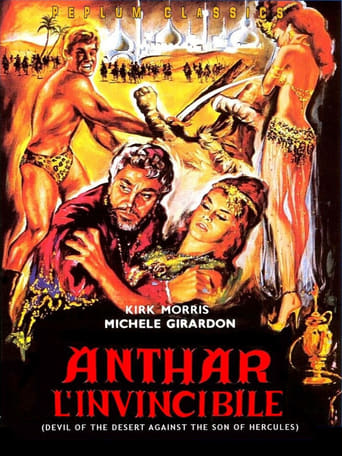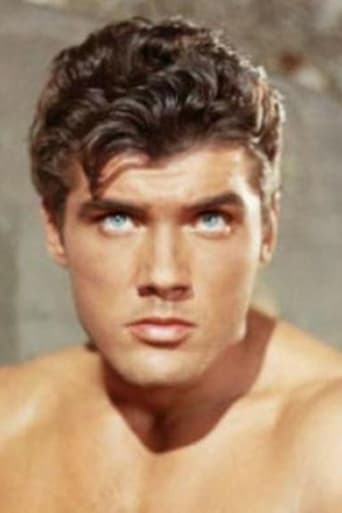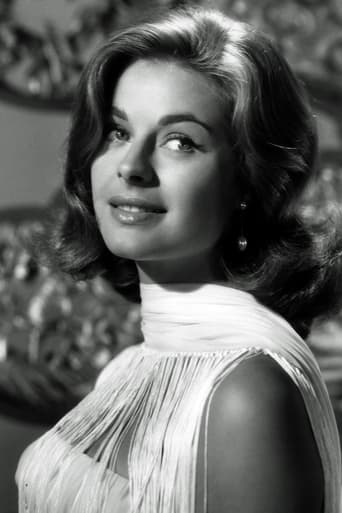

The Slave Merchants (1964)
The daughter of a noble man is sold into slavery, only to be later rescued by the film's hero. Repackaged from an original Sword-and-Sandal italian film.
Watch Trailer
Cast
Reviews
From my favorite movies..
As somebody who had not heard any of this before, it became a curious phenomenon to sit and watch a film and slowly have the realities begin to click into place.
Let me be very fair here, this is not the best movie in my opinion. But, this movie is fun, it has purpose and is very enjoyable to watch.
The film never slows down or bores, plunging from one harrowing sequence to the next.
A lively peplum adventure, directed by Antonio Margheriti and thankfully a lot more appealing than his HERCULES, PRISONER OF EVIL made in the same year. The print under review is the edited US TV print, complete with incredibly catchy "Sons of Hercules" theme tune, which eliminates plenty of plot exposition to concentrate solely on the action, which is fine by me. The various plot elements involve beautiful princesses, a fair bit of exotic dancing, a really annoying "comic relief" mute sidekick who grunts his way through the movie and our hero, Anthar, dressed in what alarmingly appears to be a giant nappy! Genre veteran Kirk Morris sails through the role and enjoys himself beating up extras, causing mass destruction and generally taking on men ten-to-one. The English dubbing turns him into a rather more sadistic character than we usually see, saying the likes of "I'll rip your eyes out!" to an injured enemy soldier! The entertaining finale involves an amazing wall-climbing episode in which aforementioned mute boy uses a row of spears to swing acrobatically up to the top of the battlements. This is quickly forgotten as we're witness to a really bizarre arena fight sequence in which Anthar finds himself up against a rhinoceros, of all things! Although the fight is short it still sticks in the mind. The final battle involves plenty of cool deaths for villains (spearing, crushing by rhinoceros and impalement by portcullis to name but three) and a (literally) smashing hall-of-mirrors showdown which seems to have inspired the climax of a certain ENTER THE DRAGON starring Bruce Lee! Quick snippet of info: watch out for the identity of the assistant director - it's none other than Ruggero Deodato, he of later cannibal-nasty infamy!
More an Arabian Nights adventure than a "Hercules" movie, this minor entry in the Sword-and-Sandal cycle lacks the verve, polish, and tongue-in-cheek humor needed to lift it above the level of the "forgettable." While the casting of Kirk Morris might lead one to expect generous servings of "beefcake," his initial appearance is the only scene in which he appears completely bare-chested. After that he's usually seen in a bolero jacket which shows off his arms and stomach but which, unfortunately, makes him look more like a comic side-kick than a two-fisted hero. Also, despite expectations to the contrary, Morris is not subjected to one of those torturous tests-of-strength which showcases his musculature in a bondage situation replete with homoerotic imagery. Instead, he's simply thrown into a pit with an irritated rhino -- a sequence which must have seemed better on paper than it proves to be on film. While not a bad movie -- it's passably entertaining in a Saturday matinée sort of way -- fans of this genre in general and of Kirk Morris in particular are advised to look for their satisfaction elsewhere.
I don't know about you, but the first appearance of Anthar (Kirk Morris) and his mute friend seemed a bit disturbing, adding fuel to the argument that the genre has a special appeal for gay audiences. Their attire, if it can be called that, looks like over-sized diapers, and speaking from a non prurient perspective, they look embarrassing as all get out. Fortunately, the rest of the adventure calls for Greek warrior wardrobe, but it's not enough to save the flick from desert boredom.The print I viewed didn't help matters any, it was almost entirely washed out with shades of red as the predominant Technicolor hue, with an annoying bar that ran up and down the picture for most of it's run. Incessant desert sequences seemed to dominate the first half, but I'll give more than a fair share of credit for impressive costume design for all the slave traders, warriors and harem girls on hand. If the movie had been more than a beefcake film, it might have been a contender for Best Costune Design, won that year by "My Fair Lady".Hey, how about Gainor's glass cage chamber of death? I'm a little confused about how Anthar could have gotten so close to observe it's inner workings when Gainor dispatched Akrim the slave trader. Obviously it came in handy when it was his turn, giving new meaning to the phrase - "If it ain't fixed, break it".For his part, Kirk Morris provides one of the more agile characterizations of a Herculean namesake; a lot of his moves look like they came off of an off screen trampoline. I wouldn't be surprised to learn if that was the case. Correct me if I'm wrong, but it also seemed like whenever Anthar appeared ready for battle, he always wound up starting a fire. Perhaps with 'Devil' in the title, a fiery presence was deemed necessary to heat up the action.
This review is of the US TV print, THE DEVIL OF THE DESERT AGAINST THE SON OF HERCULES, which is probably edited. For some reason, a number of the sword-and-sandal films starring Kirk Morris put him in varied settings--Scotland, Atlantis,the Steppes of Russia, a generic "Arabic" setting. This one is set in the latter and does have some nice North African location shooting in a few scenes. It's the usual story of the daughter of nobility whose father is slain by an evil tyrant and who is sold into slavery, only to be saved by an honest, strong, brave man of common origin but renowned among the common people. Morris, who doesn't enter the film for at least ten minutes as the problem is established, is not usually given a lot of pages of dialogue in his films, and that's true here too, but like any stoic hero he doesn't need to say much because his actions speak louder than words and because all the words he speaks are of significance. The director here is Anthony Dawson/Antonio Marghetti, who has done many classics in the Italian Western and Horror fields. Here, he provides many unexpected visuals and keeps the pace moving quickly. The set design is vivid and unusual throughout also. This is an above average peplum film, fortunately in color (many US TV prints of sword and sandal films are B&W versions of films originally made and shown in Europe in color). I expect that someday these films will come to DVD in unedited form, letter boxed, in sparkling transfers, with original credits, such as has been done to Mario Bava horror films and various Italian westerns. But that day isn't here yet, so until then check the internet for VHS copies. If you like the genre, this one is worth seeing for the offbeat setting and the exciting pace. PS, Morris' mute sidekick is usually called Amute, but in one scene he is called, twice, something that sounds like "mosquito." Is that an Italian diminutive term of affection or a character name? Anyone know?


